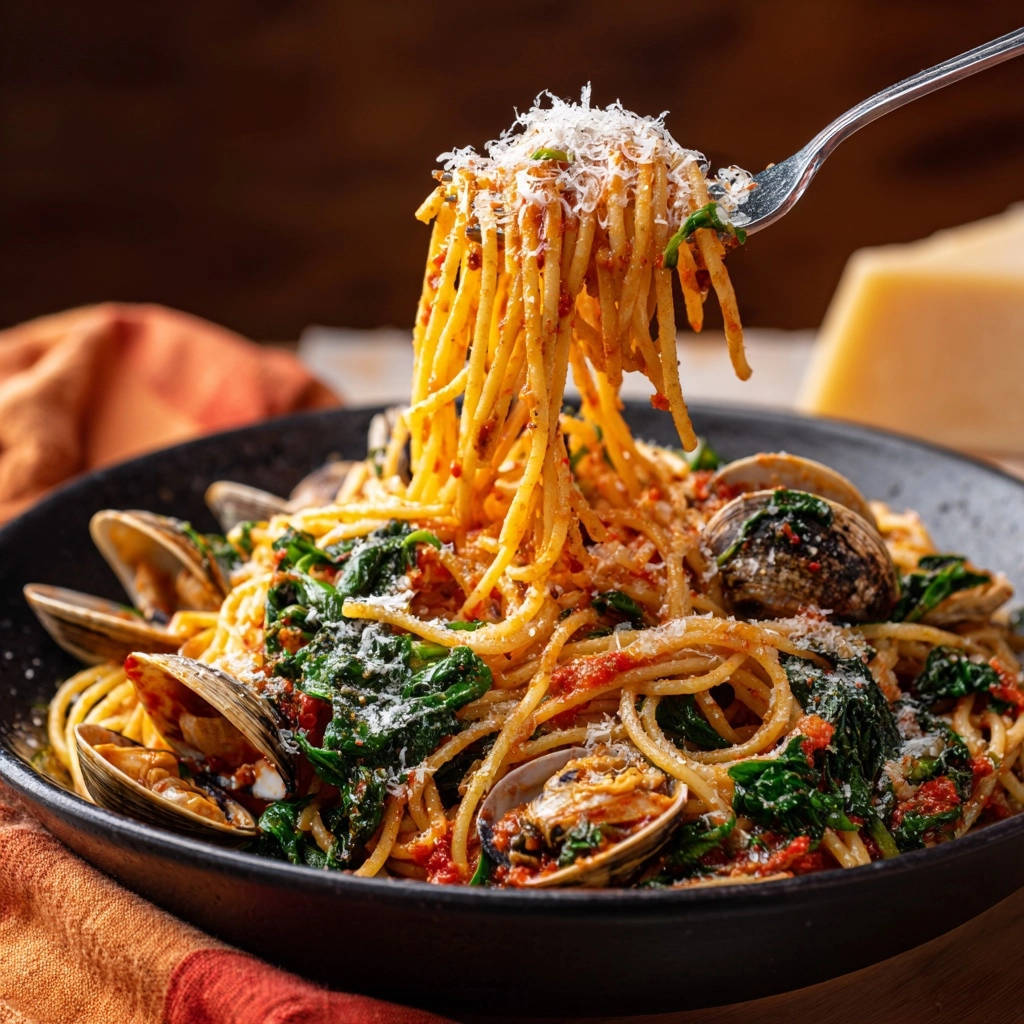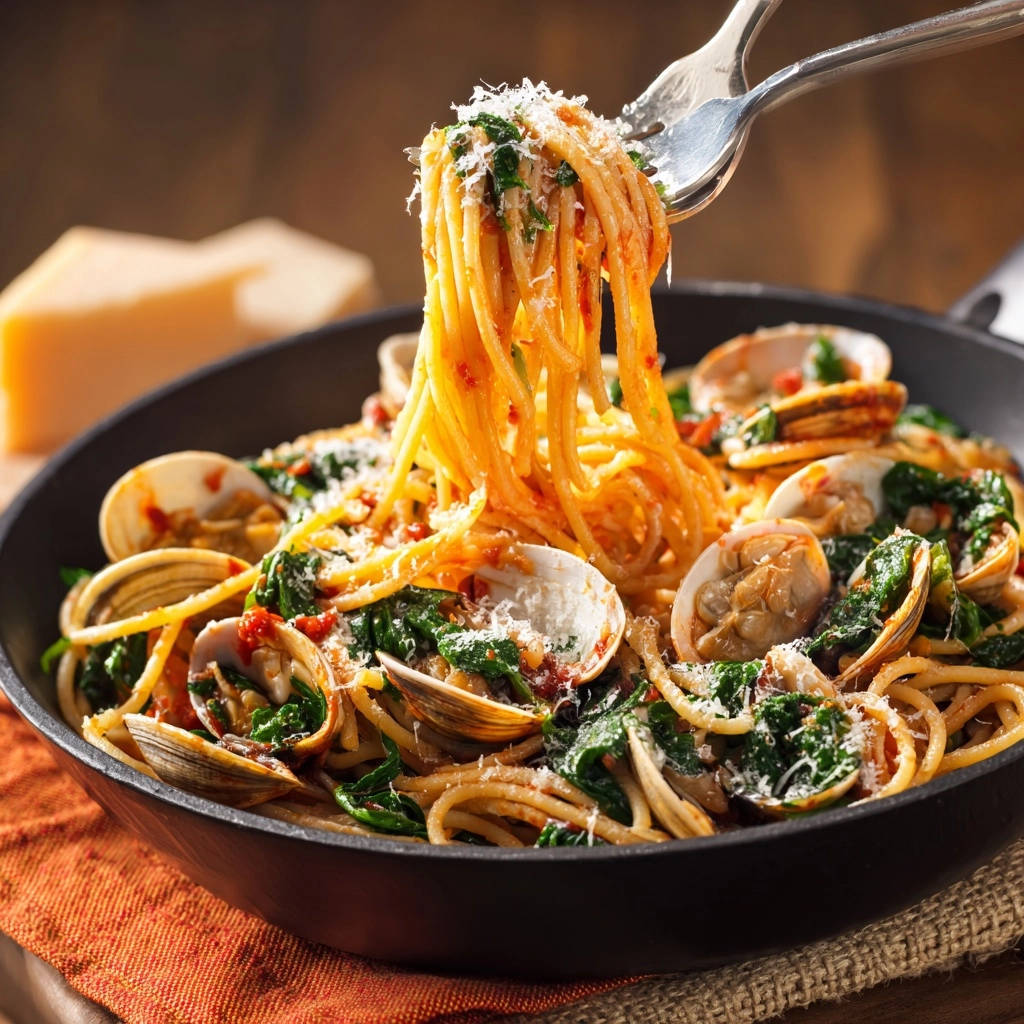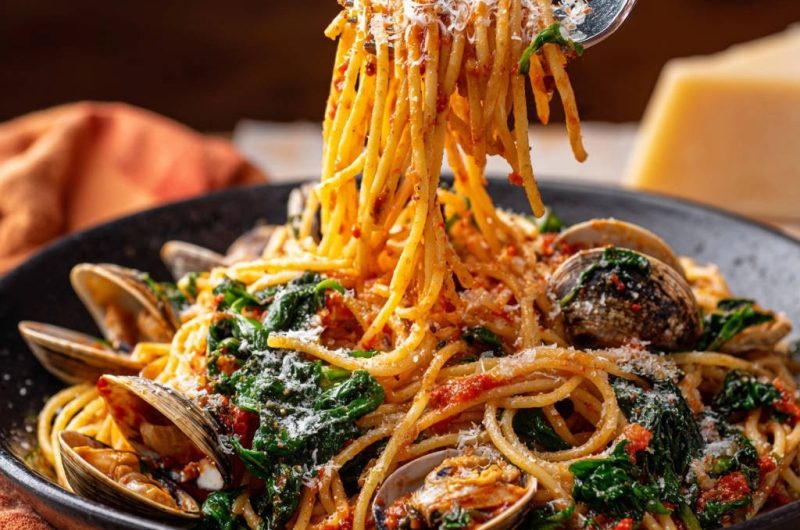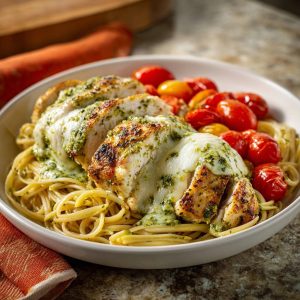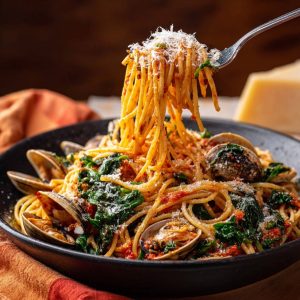I’ve spent years perfecting seafood pasta, and the most common disappointment is a thin, broken sauce that slides right off the noodles and pools at the bottom of the bowl.
This technique for Spaghetti with Clams and Spinach solves that problem instantly, guaranteeing a restaurant-quality, velvety coating that adheres perfectly to every strand of pasta.
We rely on simple starch science and a specific final tossing method to achieve this perfect gloss and texture, building immense trust and flavor.
Say Goodbye to Watery Pasta Sauce: The Secret to a Perfect Cling
Achieving a truly professional seafood pasta coating isn’t magic; it’s a technique centered on vigorous emulsification during the final minutes of cooking.
A watery sauce occurs when the fat (olive oil) and the liquid (tomato/clam liquid) fail to integrate, causing them to separate and pool.
Our method introduces reserved, highly starchy pasta water during the crucial last step, binding the oil and liquid together into a single, cohesive, shiny glaze.
This simple addition ensures the sauce adheres seamlessly to every piece of the spaghetti, transforming this classic dish from satisfying to truly exceptional.
Essential Building Blocks: Selecting Ingredients for Maximum Flavor
Here is a quick overview of the essential ingredients required for this flavor-packed dish:
- 1 pound spaghetti or linguine
- 2 pounds fresh clams, scrubbed and purged
- 1/4 cup olive oil, divided
- 4 cloves garlic, thinly sliced
- 1 teaspoon red pepper flakes (optional)
- 1 (14.5 ounce) can crushed tomatoes
- 1 cup clam steaming liquid (or high-quality non-alcoholic stock/water)
- 5 ounces fresh spinach, roughly chopped
- 1/2 cup grated hard cheese (Parmesan or Pecorino)
- Salt and black pepper to taste
Choosing and Purging the Perfect Clams
Clam quality is paramount for this seafood pasta. Littleneck clams are generally preferred for their sweet flavor and consistent size, ensuring they cook evenly.
Always inspect them for freshness; they should smell briny, not fishy, and their shells should be tightly closed or snap shut when lightly tapped.
The critical purging step-submerging them in cold, salted water for 30 minutes-encourages the clams to expel any internal sand or grit, which is essential for a clean, enjoyable bite.
The Best Pasta Shape for Sauce Adherence
We specifically use spaghetti or linguine because long, thin noodles maximize the surface area for the emulsified sauce to cling to effectively.
The texture of the noodle matters significantly; if possible, select high-quality, bronze-die extruded pasta, which has a slightly rougher surface that grips the sauce much better than smooth varieties.
Building Depth: Tomatoes, Aromatics, and Clam Liquid
Crushed tomatoes provide a concentrated, rustic texture without the chunkiness of diced tomatoes, integrating smoothly into the final glossy sauce.
Garlic must be thinly sliced, not minced, to prevent it from scorching during the initial sauté, which can introduce significant bitterness to the entire dish.
Reserving the liquid used to steam the clams is non-negotiable; this highly concentrated liquid reinforces the intense seafood flavor base, far surpassing plain stock or water.
Pro Chef Techniques: Mastering the Method for Spaghetti with Clams and Spinach
-
Purging the Clams: The First Crucial Step
A grit-free experience starts here. Give the clams a full 30 minutes in cold, heavily salted water; this relaxing environment encourages them to filter themselves cleanly.
After this process, firmly discard any clam that remains stubbornly open even after a light tap, as this indicates it may not be alive and could pose a food safety risk.
-
The Al Dente Secret: Cooking the Pasta Under Time
The most common pasta mistake is cooking it completely in the pot. We must pull the spaghetti 2 minutes shy of al dente-it should still feel very firm at the core.
This intentional undercooking ensures the noodles are ready to finish absorbing flavor and residual starch directly in the sauce, preventing them from becoming mushy later.
-
Reserving the Starchy Water (A Non-Negotiable Step)
Always reserve at least two cups of the cooking water before draining. The cloudiness indicates high starch content, which is the necessary binding agent for the upcoming emulsification.
This cloudy liquid is liquid gold; never pour it all down the drain, or you will struggle to achieve the desired glossy finish.
-
Building the Deep Tomato Base and Steaming the Clams
Start by gently heating 3 tablespoons of the olive oil with the sliced garlic and pepper flakes over medium heat for one minute. If the garlic browns quickly, the heat is too high, and the scorched garlic must be removed immediately.
Stir in the crushed tomatoes and simmer for five minutes to deepen their sweetness, then add the cleaned clams and cover immediately.
Use medium-high heat to generate the necessary steam quickly, ensuring the clams open efficiently within 5 to 8 minutes, then discard any that remain closed.
The Emulsification Technique: Making Your Sauce Glossy and Velvety
The Science of Sauce Cling: Starch Meets Oil
Emulsification is the process of forcing oil and water (or in this case, clam liquid and tomato) to combine into a stable mixture, which is achieved through a binding agent called an emulsifier.
In this Spaghetti with Clams and Spinach, the residual starch from the reserved pasta water acts as that crucial emulsifier, coating the individual oil droplets and keeping them suspended evenly within the sauce.
The result is a uniformly creamy, glossy texture that coats the pasta beautifully without relying on heavy cream or flour-based thickening agents.
The Tossing Vigor: Why Vigorously Stirring is Key
Physical action is required to initiate the chemical binding. Using tongs, transfer the undercooked spaghetti directly into the pan with the sauce and a starting half-cup of reserved water.
You must toss and stir the pasta very vigorously for the full two minutes while the pan is still over medium-low heat. This friction is essential for releasing the remaining starch from the noodles and integrating it into the liquid.
Keep a close eye on the visual cues: the sauce should transition from a thin liquid to a thick, opaque, and shiny glaze, adding additional pasta water one tablespoon at a time if it becomes too dry.
Finishing the Dish: Achieving Perfect Texture and Seasoning
-
Incorporating Fresh Spinach and Final Drizzle
Remove the pan from the heat immediately before adding the fresh spinach. The residual heat from the pasta and the skillet is sufficient to gently wilt the greens without overcooking them or losing their vibrant color.
The final tablespoon of high-quality olive oil, drizzled over the finished dish, is a common Italian technique called a crudo. It significantly improves the raw fragrance and adds a beautiful, final sheen to the sauce.
-
Cheese and Flavor Check
Hard cheeses like Pecorino Romano add necessary sharpness and saltiness that beautifully complements the acidity of the tomatoes and the briny richness of the clams.
Always perform a final seasoning check. The saltiness will change drastically after the cheese and spinach are incorporated, so adjust with additional salt and pepper right before serving to hit peak flavor.
Troubleshooting Common Vongole Mistakes
Help! My Clams Won’t Open
The primary reasons are usually insufficient heat, or the clam was dead before cooking started. Ensure the liquid is steaming vigorously under a tightly sealed lid to create enough steam.
After five to eight minutes, if any clams remain closed, they must be discarded immediately for food safety reasons, regardless of how they look externally.
The Sauce Broke or Looks Too Thin
If the sauce looks oily or watery, the emulsion failed or there wasn’t enough starch released. The quickest rescue is to increase the heat slightly while tossing the pasta aggressively.
If that fails, take the pan off the heat and stir in a small knob of cold butter along with another splash of hot reserved pasta water. The cold butter helps stabilize the fat components while the starch re-binds the liquids.
My Garlic Burned While Sautéing
Burnt garlic releases bitter compounds that permeate the entire seafood pasta sauce and cannot be removed. The solution is starting the cooking process with cold olive oil and the sliced garlic over medium-low heat.
This technique allows the garlic flavor to infuse the oil gently before the temperature gets too high. Never let the garlic darken past a light golden color.
Chef’s Secrets: Elevating Your Spaghetti with Clams and Spinach Game
-
Maximizing Clam Flavor: For an added layer of acidity and depth, consider using a dry white wine (like Pinot Grigio) instead of stock or water during the clam steaming phase. The alcohol evaporates, leaving behind a complex, bright flavor note.
-
The Butter Finish: Stir in one tablespoon of cold butter off-heat with the spinach and the final oil drizzle. This technique, common in restaurant kitchens, boosts the richness and further stabilizes the emulsion for a richer, glossier mouthfeel.
-
Spice Level Control: If you are using red pepper flakes, bloom them in the oil briefly before adding the garlic. This extracts their flavor into the fat base first, distributing the heat evenly without overwhelming the delicate clam flavor.
Frequently Asked Questions About Seafood Pasta
Can I Make This Recipe Using Canned Clams?
While fresh clams offer superior texture and flavor, canned clams can be used in a pinch. Drain them well and add them only at the very end of the cooking process, using the drained liquid for the sauce base.
Be careful not to overcook canned clams, as they become rubbery quickly. The richness of this tomato-based Spaghetti with Clams and Spinach helps compensate for the lack of fresh clam brine.
Is Hard Cheese Acceptable with Seafood?
The traditional Italian rule suggests avoiding cheese with delicate white wine seafood sauces. However, this is a robust, acidic tomato-based dish, which is a key difference.
The sharp, salty profile of Pecorino or Parmesan cuts through the richness of the tomato and complements the briny flavor, acting more as a necessary seasoning than a primary ingredient.
How Do I Store and Reheat Leftovers Safely?
Store leftovers in an airtight container for up to three days refrigerated. Due to potential quality degradation, do not keep cooked clams longer than this period.
To reheat, transfer the pasta to a skillet over low heat and add a small splash of water or stock. Gently toss until the sauce re-emulsifies, returning the dish to a moist, delicious state rather than a dry clump.
Ready to Impress? Share Your Spaghetti with Clams and Spinach Masterpiece!
Mastering the emulsification technique is the single greatest upgrade you can give your pasta game. This simple scientific approach guarantees a silky, glossy sauce every time you tackle a seafood dish.
Once you see the transformation of the sauce clinging perfectly to the spaghetti, you will find yourself applying this method to every oil-and-water-based pasta recipe you create.
Now that you hold the secret to the perfect glossy coating, gather your ingredients and get ready to serve the most impressive plate of Spaghetti with Clams and Spinach you’ve ever made!
Spaghetti with Clams and Spinach
Course: Main CourseCuisine: Italian CuisineDifficulty: easy4
servings15
minutes25
minutes40
minutesItalian Cuisine
Ingredients
1 pound spaghetti or linguine
2 pounds fresh clams, scrubbed and purged
1/4 cup olive oil, divided
4 cloves garlic, thinly sliced
1 teaspoon red pepper flakes (optional)
1 (14.5 ounce) can crushed tomatoes
1 cup clam steaming liquid (or high-quality non-alcoholic stock/water)
5 ounces fresh spinach, roughly chopped
1/2 cup grated hard cheese (Parmesan or Pecorino)
Salt and black pepper to taste
Directions
- Purge and Prep Clams: Submerge the cleaned clams in a bowl of cold, salted water for about 30 minutes to encourage them to spit out any sand. Discard any clams that remain open after being lightly tapped.
- Cook the Pasta and Reserve Water: Bring a large pot of salted water to a rolling boil. Add the spaghetti and cook only until 2 minutes shy of al dente (the pasta should still be slightly firm). Before draining, reserve at least 2 cups of the starchy pasta cooking water. Drain the pasta and set aside.
- Build the Sauce Base: Heat 3 tablespoons of the olive oil in a large skillet or wide pan over medium heat. Add the sliced garlic and red pepper flakes (if using) and saute for 1 minute, being careful not to let the garlic scorch. Stir in the crushed tomatoes, season lightly with salt, and let simmer for 5 minutes until the flavor deepens.
- Steam the Clams: Add the cleaned clams and the 1 cup of clam steaming liquid (or stock) to the tomato base. Cover the pan immediately and increase the heat to medium-high. Steam for 5 to 8 minutes, shaking the pan occasionally, until the clams have fully opened. Discard any clams that do not open.
- The Emulsification Technique (The Key to Non-Watery Sauce): Reduce the heat to medium-low. Using tongs, transfer the slightly undercooked pasta directly into the large skillet with the sauce and clams. Add 1/2 cup of the reserved starchy pasta water. Toss and stir the pasta vigorously for 2 minutes. The starch in the reserved water will combine with the oil and tomato liquid, creating a thick, glossy, emulsified sauce that adheres perfectly to the noodles. Add additional pasta water, a tablespoon at a time, until the sauce reaches your desired creamy consistency.
- Finish the Dish: Remove the skillet from the heat. Stir in the fresh spinach until it is wilted (this happens quickly from the residual heat). Drizzle with the remaining 1 tablespoon of olive oil and stir in half of the grated cheese. Taste and adjust seasoning with salt and pepper.
- Serve immediately, topped generously with the remaining grated hard cheese.
Notes
- The key technique involves vigorous stirring with reserved starchy pasta water to emulsify the sauce.

